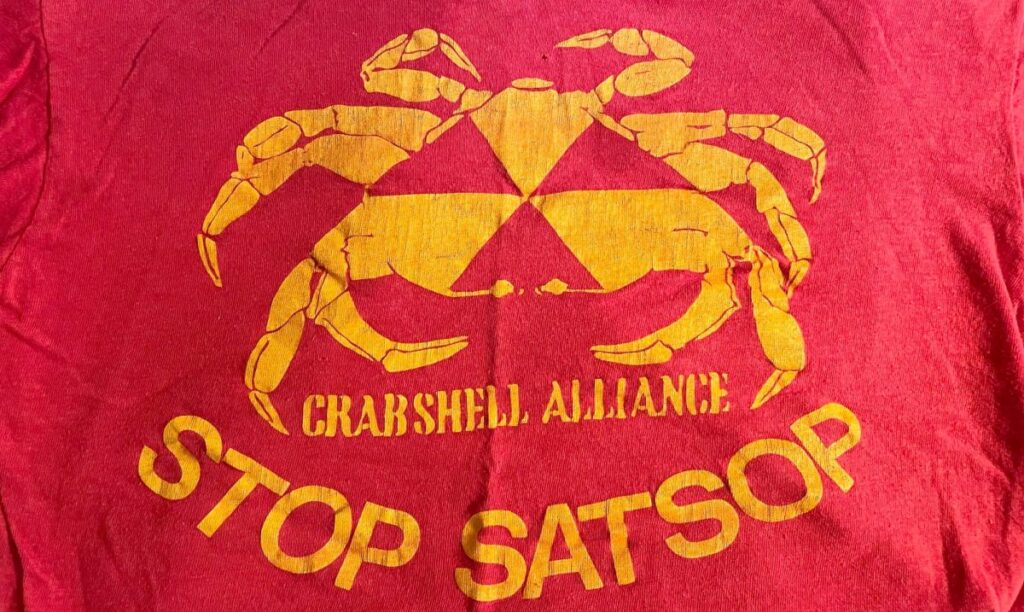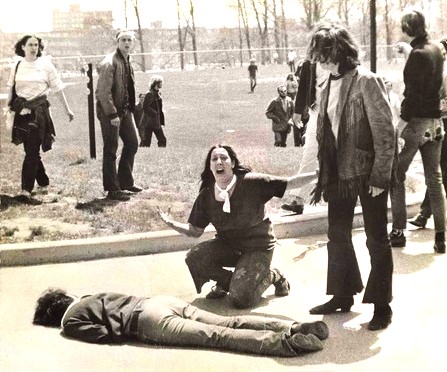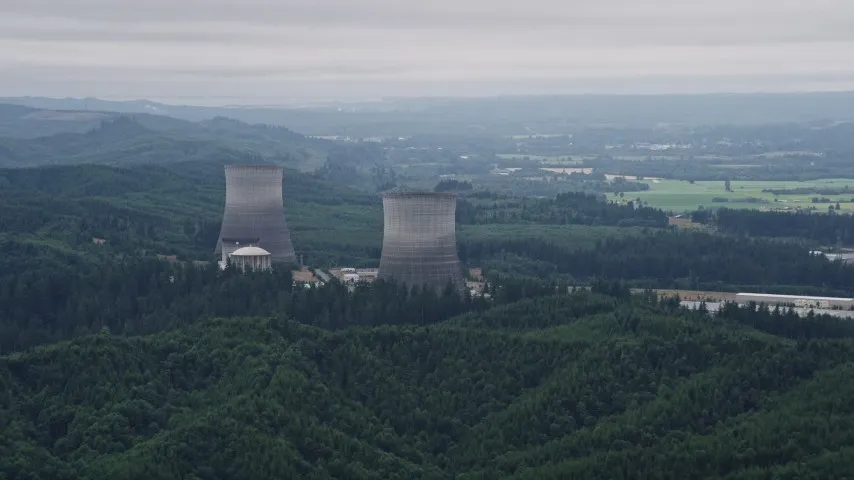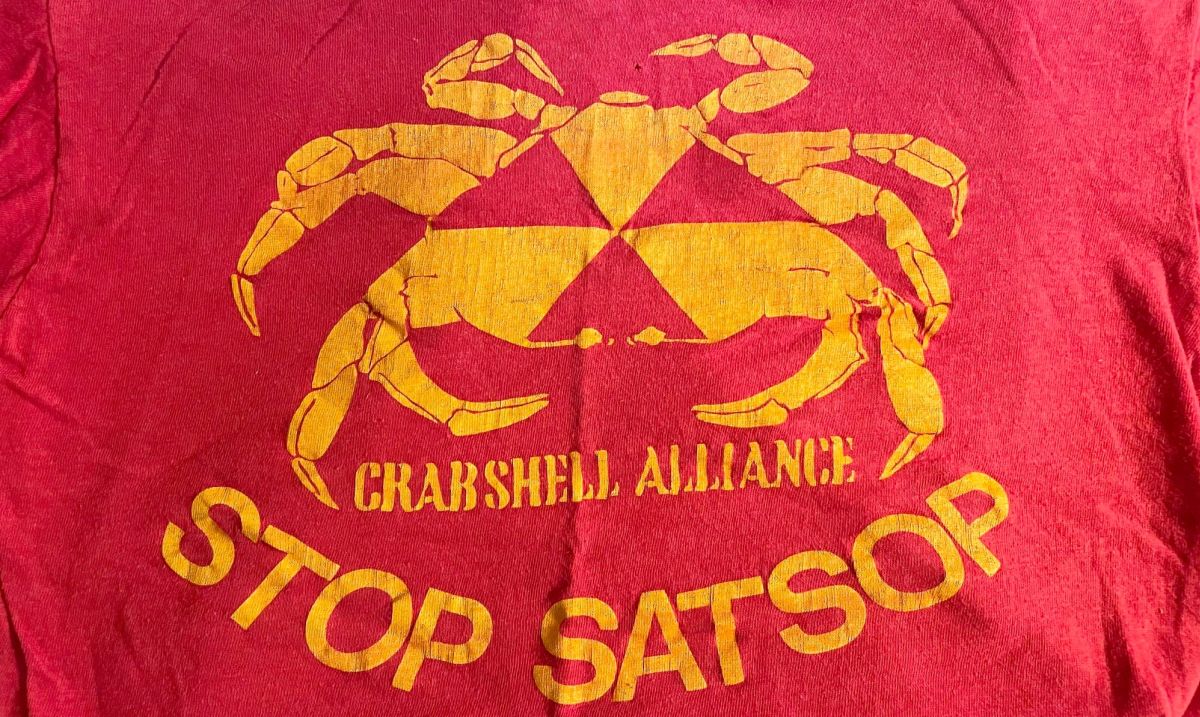ACTIVISM
Violence and Non-Violence: A Tale of Two Tactics
By Anna Schlecht

Crabshell Alliance was a VERY different kind of political action group for me. Up until 1975, my political experience had involved bouncing around the antiwar movement in Madison, Wisconsin, most of which was DIY, male-dominated, and raucous. But in Crabshell Alliance, I found myself part of a well-organized effort with clear strategies, effective tactics, and women in leadership. Vastly different.
The anti-Vietnam-War movement embraced a wide range of tactics. At one end of the continuum was one of my idols, Abbie Hoffman, who was both a serious antiwar leader as well as a talented political jester who recognized the immense value of humor and theater as a way to inspire war resistance. Hoffman wrote a manual for activists titled Steal this Book which explained how to “Survive! Fight! And Liberate! In the prison that is AMERIKA.” This book was everything to us high school-aged radicals, and I definitely stole my copy.
The manual I really needed would have been a safety guide on how to avoid the sexual predators that were rampant in the antiwar movement. Young women, especially teenage activists like me, were easy prey for older men. This is not to say that leftist men were the only predators—the same abuse almost certainly happened among young Republicans, but you wouldn’t know because right-wing women didn’t talk about sex at all, much less sexual abuse. In those days, there was a complete lack of political analysis of rape and domestic violence, and it never occurred to me that liberation for women was important as liberation for Third World countries fighting imperialism. Those experiences of dodging all the sexist vultures drove many women like me into the women’s movement.
Back in the late 1960s and early 1970s, Madison was a hotbed of antiwar action. I was part of high school student walkouts, and I often went downtown for rallies that turned into riots once the police arrived with their clubs and tear gas. I always wore a coat with big enough pockets to carry bandanas, along with baking soda and water to mix up the tear gas antidote.
While I was still in high school, the ROTC got bombed so often that the recruiters resorted to having a plain storefront without a sign. My most vivid memory was the August 1970 bombing of the University of Wisconsin’s Sterling Hall in Madison. As a young teenager, I was stunned by the scope of destruction and the death of a late-night researcher, Robert Fassnacht, who was caught in the blast. A few years later one of the bombers, David Fine, would hold his legal defense team meetings in the back room of the Main Course Restaurant, my hippie collective. Talk of the bombing rumbled across the political landscape with activists all over Madison immersed in an impassioned debate of tactics—do we fight violence with violence or should we flip the script and respond with nonviolence? Once I started school at the University of Wisconsin, I saw that the building was left in a state of partial destruction as a deterrent to other potential activists, kind of like, “Watch out—this is what happens when you go too far.”
The Sterling Hall bombing was inspired in part by the Kent State and Jackson State shootings which had occurred a few months earlier. State police in both incidents fired on students, killing four at Kent State and two at Jackson State. The Ohio State police actually bayoneted some of the protestors, a horrifying tactic that in my teenage niavety I thought had not happened since the French Revolution. I was deeply affected by the searing image of a horrified teenager kneeling over the body of a murdered Kent State student. This girl, Mary Ann Veccio, was my age. It could have been me. While the Vietnam War was raging on the other side of the globe, it seemed that we were on the verge of a civil war here. Like one of the slogans seen on many signs and banners, “They can’t kill all of us,” I thought they could never stop us.

For White kids my age, this was the first experience with violent political repression. Some of the older White activists I knew had been part of the civil rights movement and had gone south as allies for Black activists who constantly faced threats, assaults, and murder. For me, this was a more distant reality. As many journalists pointed out, this was the first time that middle-class White kids got gassed, clubbed, and even murdered.
By 1974, Nixon left the White House in disgrace and the Vietnam War ended the following year. The Wisconsin campus that once pulsed with antiwar fervor had devolved into an apolitical party scene. The Library Mall near Lake Mendota that had been the battle zone of protestors versus riot cops was now filled with fraternities hosting huge outdoor costume parties. I felt deeply disillusioned and wanted no part of college life.
The worldview of my generation had shifted. There was no longer a sense that revolution was imminent, instead many of us began to look for ways to create smaller revolutionary communities. Thousands of us flocked to the West Coast looking for a fresh start.
Around this time, the emergent antinuclear movement created a hugely different approach to political organizing. In 1973, President Nixon had rolled out a plan called Project Independence to make the US energy self-sufficient by 1980 through conservation programs and conversion to “alternative” energy sources. These new sources were going to be nuclear power plants, with a goal to build 1,000 by the year 2000. While the idea of energy conservation was a huge hit with environmentalists, the nascent nuclear power industry seemed to be driven by corporate profits more than conservation, much less public safety.
The high risks posed by these plants were being exposed by industry insiders like Karen Silkwood who died in a suspicious car accident while driving to a New York Times interview. The dangers of nuclear power were detailed by journalists and activists across the country in pamphlets, leftist publications, and even the mainstream press. The first domestic nuclear plant accident occurred in Idaho Falls in 1961 with another at Three Mile Island in 1979. While the most catastrophic accident occurred 10 years later in 1986 at the Chernobyl plant in Ukraine, the potential for nuclear disaster was a real and present danger.
Here in Washington, opposition to nuclear power was being organized by the Crabshell Alliance. Crabshell was one of several alliances using aquatic names, including the Clamshell Alliance in the Northeast, and the Abalone Alliance in Southern California. While separated by thousands of miles, there was a call and response dialogue between organizers that harmonized our approaches. This kind of collaboration—sending copies of regional pamphlets and posters across the country by mail—gave me a deeper understanding of the movement I was a part of.
The Olympia Food Co-op where I worked was one of the recruitment hubs for the Crabshell Alliance. The Crabshell organizers were seeking people from the greater Olympia area to join the opposition to stop a nuclear power plant under construction at Satsop. At first glance, Crabshell and the entire antinuclear movement fit the model of leftist activism—getting the largest number of people to go to a protest and raise hell. But quickly the differences emerged.
First, we all had to sign up to take nonviolence training. I attended a class held in a church to learn about civil disobedience. Our teacher, Ada Keith, had learned about civil disobedience by attending the Highlander Folk School, a training center in Tennessee for social justice activists and leaders.
I knew about the Highlander School because one of the high school teachers at my free school (the term for alternative high schools in those days) was Thorsten Horton, the son of Myles and Zilphia Horton who were founders of this school. I took a couple of classes with Thorsten where I learned a little bit about Highlander School, its values, and the overall philosophy of nonviolent civil disobedience. But at the time I had no idea of the significant role that this school played in the Black civil rights movement, influencing icons like James Bevel, Rosa Parks, and Martin Luther King in their work.
At the time, all this nonviolent training seemed like a lot of added work to slow us down. Once we got through our training, I impetuously wanted to head straight out to the nuclear power plant and start protesting. But, next came the formation of affinity groups.
All the new recruits had to join a Crabshell affinity group. Mine had some amazing people, a couple of whom I still know. While we had all gone through our training together, we still needed to meet a few times to strengthen our bonds before the action.
Together, we went over our nonviolence training readings, discussions, and role plays. The organizers wanted us to be prepared before going out to Satsop and other nuclear power plant sites. We acted out all of the steps involved in our planned actions: how to approach the gate, how to sit down and link arms, how to respond to being arrested, and generally how to treat people with mutual respect. I found that approach—standing up to physically rehearse our plan—was a technique to create a body memory of what to do, and it helped to get us out of our heads. Most of us had read lots of books about revolutionary theory and history. Instead, this approach was a practical how-to. It also allowed us to tap into the human level of our actions without being herded by the intellectualized theory where sometimes people are concepts more than flesh and blood.
The Trident Nuclear Submarine base was located near Bangor, Washington, which was up on the Kitsap Peninsula on the eastern side of Hood Canal. Since it was a submarine base, there wasn’t much to see unless the subs rose to the surface.

Satsop, however, was a highly visible presence in an otherwise bucolic area near Elma. The project was managed by the Washington Public Power Supply System, commonly known as “Whoops!” The surrounding area felt like occupied territory once WPPSS began construction on the two giant cooling towers. I remember looking out the window while driving there and seeing the towers that were visible for miles, sticking up over the trees like the Eye of Sauron tower in the Lord of the Rings.
Our affinity group joined in a couple of mass actions. Once we got to the sites, things went pretty quickly. Months of preparation yielded to a rapid chain of events. As all of our affinity groups sat down in front of the gate we were swarmed by police and company officials ordering us to leave. Waves of arrests began soon after the warnings. Then we were all loaded onto buses that took us away to be processed. Once we were processed, we’d be released to our support teams, all part of a fleet of hippie cars and trucks to ferry us home. Soon thereafter we would hold a debrief to examine what worked, what didn’t, and what we each learned.
Every step of the way was guided by principles of nonviolent civil disobedience and mutual respect. Having been minted in the boisterous days of the antiwar movement, the more deliberative tenor of the no nukes movement was deeply impactful. Differing from the open warfare between activists and riot cops, we all learned that nonviolent resistance did not involve breaking windows or wrestling with the police.
Our affinity group was musically inclined so we got mimeographed copies of antinuke songs. These were clever rewrites of familiar tunes that were recast as a no-nukes songbook. We performed them everywhere we could—rallies, fundraisers, and other events. We called ourselves something catchy like the Crabshell Chorus. We were nowhere near as good or well known as the Seattle-based group called Shelly and the Crustaceans, but we did have our own little following.
Ultimately, Satsop collapsed under its own bad management. Later on, when I got a job working for the City of Olympia, I learned that WPPSS had become a cautionary tale because it suffered through the largest municipal bond default in US history. However, Trident was impervious to our protests and continued as one of the US military’s primary nuclear submarine bases.
Like many political movements, Crabshell Alliance faded into the background and activists moved on to do other work. What has remained for me and many other participants was the way we did the work—using principles of nonviolence, making decisions by consensus, and respecting the leadership of women. For me, this was the beginning of shifting toward women-led political activism.
We encourage readers to contact us with comments and corrections. Disclaimer

